DIY Lawn Turf Installation Guide: Step-by-Step
Are you looking to transform your Orange County property with a lush, green lawn? Installing turf yourself can save money while giving your home a beautiful upgrade. This comprehensive DIY lawn turf installation guide walks you through everything homeowners need to know to successfully install turf in Southern California’s unique climate.
Get Free Estimate
Fill the form & we will call back!
Why Choose DIY Lawn Turf Installation?
Before diving into our step-by-step DIY lawn turf installation guide, let’s discuss why installing your own turf can be advantageous for Orange County homeowners:
- Cost savings: Professional installation can cost 2-3 times more than a DIY approach
- Personal satisfaction: Completing your own yard renovation creates pride in ownership
- Customization control: You decide exactly how your front yard or backyard looks
- Flexible timing: Work at your own pace rather than accommodating contractor schedules
- Quality assurance: You can personally inspect each step of the process
Planning Your DIY Lawn Turf Project
Assessing Your Space
The first step in any successful DIY lawn turf installation guide is proper planning:
- Measure your yard: Calculate the square footage accurately to determine how much turf you’ll need
- Consider sun exposure: Different areas of your Orange County property may receive varying amounts of sunlight
- Note existing features: Document sprinkler systems, trees, flower beds, and hardscaping that will remain
- Check drainage patterns: Identify low spots where water collects after rain
- Consider traffic patterns: Think about how people move through your yard and which areas need more durable turf
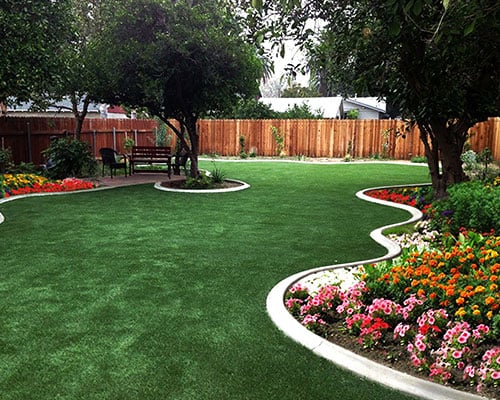
Selecting the Right Turf for Orange County
Southern California’s Mediterranean climate requires specific turf varieties that can thrive in the local conditions:
- Bermuda grass: Excellent drought tolerance and heat resistance, ideal for sunny yards
- St. Augustine: Good shade tolerance, works well in partially shaded areas
- Zoysia: Balanced drought and shade tolerance with excellent wear resistance
- Fescue blends: Good for shadier areas, though requires more water
- Artificial turf: Zero-maintenance option that’s becoming increasingly popular in water-conscious Orange County
Consider factors like water requirements, maintenance needs, and appearance when selecting your turf variety. Local garden centers specializing in Southern California landscaping can provide expert advice for your specific neighborhood within Orange County.
Essential Tools and Materials for DIY Lawn Turf Installation
Tools Needed
For a successful DIY lawn turf installation, gather these tools before starting:
- Sod cutter (rent from local hardware store)
- Rototiller (for soil preparation)
- Rake and lawn roller
- Edging tools (spade, half-moon edger)
- Utility knife or sharp garden shears
- Wheelbarrow
- Measuring tape
- Garden hose or sprinkler system
- Lawn sprinkler or irrigation components
- Compacting tool
- String and stakes for leveling
Materials Required
In addition to the turf itself, you’ll need:
- Topsoil (quality soil appropriate for Southern California)
- Starter fertilizer (appropriate for your selected turf type)
- Soil amendments (based on soil test results)
- Weed killer (pre-emergent herbicide)
- Mulch (for surrounding beds)
- Landscape fabric (for weed suppression under decorative areas)
- Edging materials (if creating new bed lines)
- Sand (for leveling)
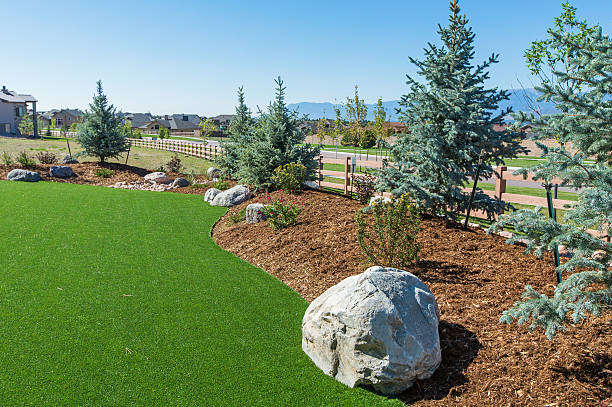
Step-by-Step DIY Lawn Turf Installation Guide
Step 1: Prepare Your Yard
Proper preparation is the foundation of any successful DIY lawn turf installation:
- Remove existing grass and vegetation: Use a sod cutter to remove old lawn and dig out any unwanted plants
- Treat for weeds: Apply appropriate herbicide and wait the recommended period
- Address irrigation: Repair, modify, or install sprinkler systems before laying turf
- Remove debris: Clear rocks, sticks, and other materials that could interfere with root development
Step 2: Soil Preparation
Soil quality directly impacts your turf’s health, especially important in Orange County’s clay-heavy soils:
- Test your soil: Have your soil analyzed to determine pH and nutrient levels
- Till the soil: Use a rototiller to loosen the top 4-6 inches of soil
- Add amendments: Mix in compost, sand, or other amendments based on test results
- Level the area: Use a rake to create a smooth, even surface
- Add topsoil: Spread a 2-3 inch layer of quality topsoil
- Compact lightly: Use a lawn roller to create a firm but not hard surface
Step 3: Turf Installation
Follow these steps for the actual turf installation process:
- Schedule delivery: Arrange for turf delivery on your installation day to ensure freshness
- Apply starter fertilizer: Spread according to package directions
- Begin installation: Start laying turf along a straight edge (like a driveway or sidewalk)
- Stagger the seams: Position turf pieces in a brick-like pattern to avoid obvious seams
- Trim edges: Use a sharp knife to cut around curves and obstacles
- Roll the turf: Use a lawn roller to ensure good soil contact
- Fill gaps: Use topsoil to fill any small gaps between turf pieces
Step 4: Post-Installation Care
The first few weeks after installation are critical for turf establishment:
- Water immediately: Thoroughly soak the new turf right after installation
- Continue watering: Keep the soil consistently moist (but not soggy) for the first 2-3 weeks
- Limit traffic: Avoid walking on new turf for at least 2 weeks
- Delay mowing: Wait until the turf has grown about 1/3 higher than your desired height
- Apply light fertilizer: Feed according to your turf variety’s needs after the first mowing

Special Considerations for Orange County Properties
Water Conservation Techniques
Given Southern California’s water challenges, incorporate these water-smart practices:
- Install smart irrigation: Consider weather-based controllers that adjust to local conditions
- Use drip irrigation: For planted borders around your turf areas
- Consider synthetic options: Artificial turf has improved dramatically and offers a water-free alternative
- Select drought-tolerant varieties: Choose grass types that thrive with minimal water
- Create hydrozones: Group plants with similar water needs together
Climate-Specific Timing
The best times for DIY lawn turf installation in Orange County are:
- Spring (March-May): Ideal for warm-season grasses like Bermuda
- Fall (September-October): Better for cool-season varieties
- Avoid summer installation: The intense heat can stress new turf
Working With Slopes and Drainage
Many Orange County properties feature slopes that require special attention:
- Install turf horizontally across slopes: This reduces runoff and erosion
- Consider terracing: For steeper areas, create level sections
- Install proper drainage: Ensure water flows away from your home’s foundation
- Use erosion control matting: For very steep areas until turf establishes
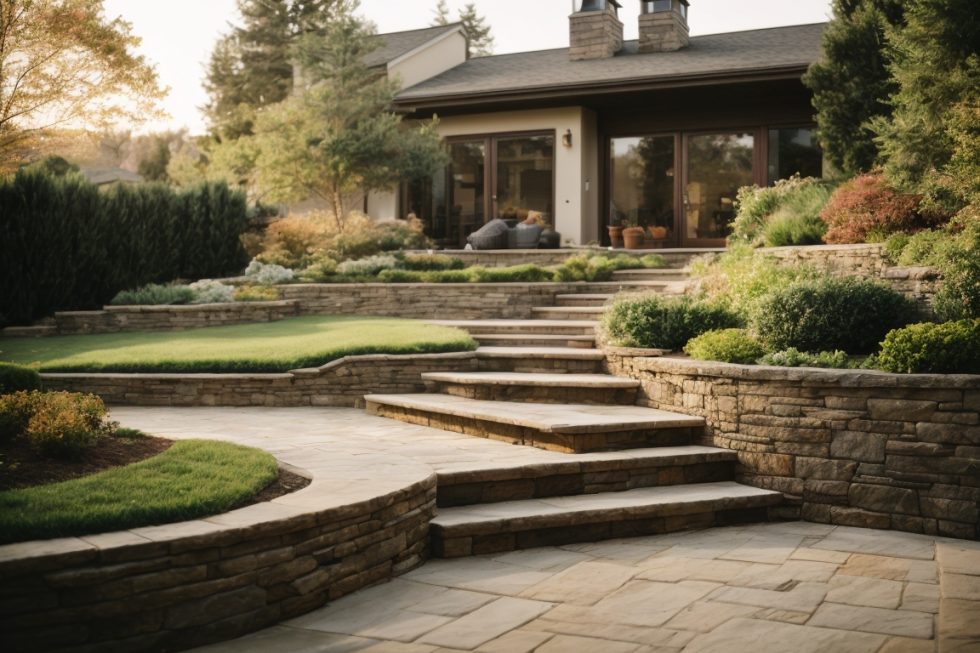
Troubleshooting Common DIY Lawn Turf Installation Issues
Addressing Brown Spots
If brown patches appear in your new lawn:
- Check irrigation coverage: Ensure sprinklers reach all areas evenly
- Inspect for pests: Look for signs of insects or grubs
- Test soil compaction: Aerate if soil is too dense
- Examine for pet damage: Create designated pet areas to protect your main lawn
Managing Weeds
Prevent and address weed problems with these strategies:
- Apply pre-emergent herbicide: Before installation and seasonally thereafter
- Hand-pull early invaders: Remove weeds before they can seed
- Maintain proper mowing height: Taller grass shades out many weeds
- Use selective herbicides: Apply only as needed for specific weed types
Fixing Uneven Areas
If you notice bumps or dips after installation:
- For small dips: Top-dress with a soil/sand mixture
- For raised areas: Carefully lift the turf, remove excess soil, and replace
- Use a lawn roller: To level minor irregularities
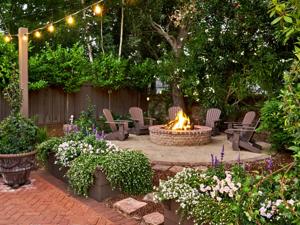
Long-Term Maintenance for Your Orange County Lawn
Seasonal Care Calendar
Follow this maintenance schedule for a thriving lawn year-round:
Spring (March-May)
- Fertilize lightly as growth begins
- Apply pre-emergent weed control
- Adjust irrigation for warming weather
Summer (June-August)
- Raise mowing height to reduce stress
- Water deeply but infrequently
- Monitor for pest issues
Fall (September-November)
- Fertilize cool-season grasses
- Reduce watering as temperatures drop
- Overseed if necessary
Winter (December-February)
- Reduce watering frequency
- Allow dormancy for warm-season grasses
- Plan for spring renovations

Water-Efficient Irrigation Practices
Maximize water efficiency with these techniques:
- Water early morning: Between 4-7 am to minimize evaporation
- Check for leaks: Regularly inspect irrigation systems
- Adjust seasonally: Reduce watering in cooler months
- Use moisture sensors: To prevent overwatering
- Consider recycled water: Where available in Orange County
Cost Analysis: DIY vs. Professional Installation
Budget Breakdown
Understanding costs helps with project planning:
DIY Installation Costs
- Turf: $0.35-$0.85 per square foot
- Soil and amendments: $25-50 per cubic yard
- Tool rental: $100-300 total
- Irrigation modifications: Varies widely
- Total DIY cost: $1-3 per square foot
Professional Installation
- Full service: $3-7 per square foot in Orange County
- Partial services available: Soil prep only, installation only, etc.
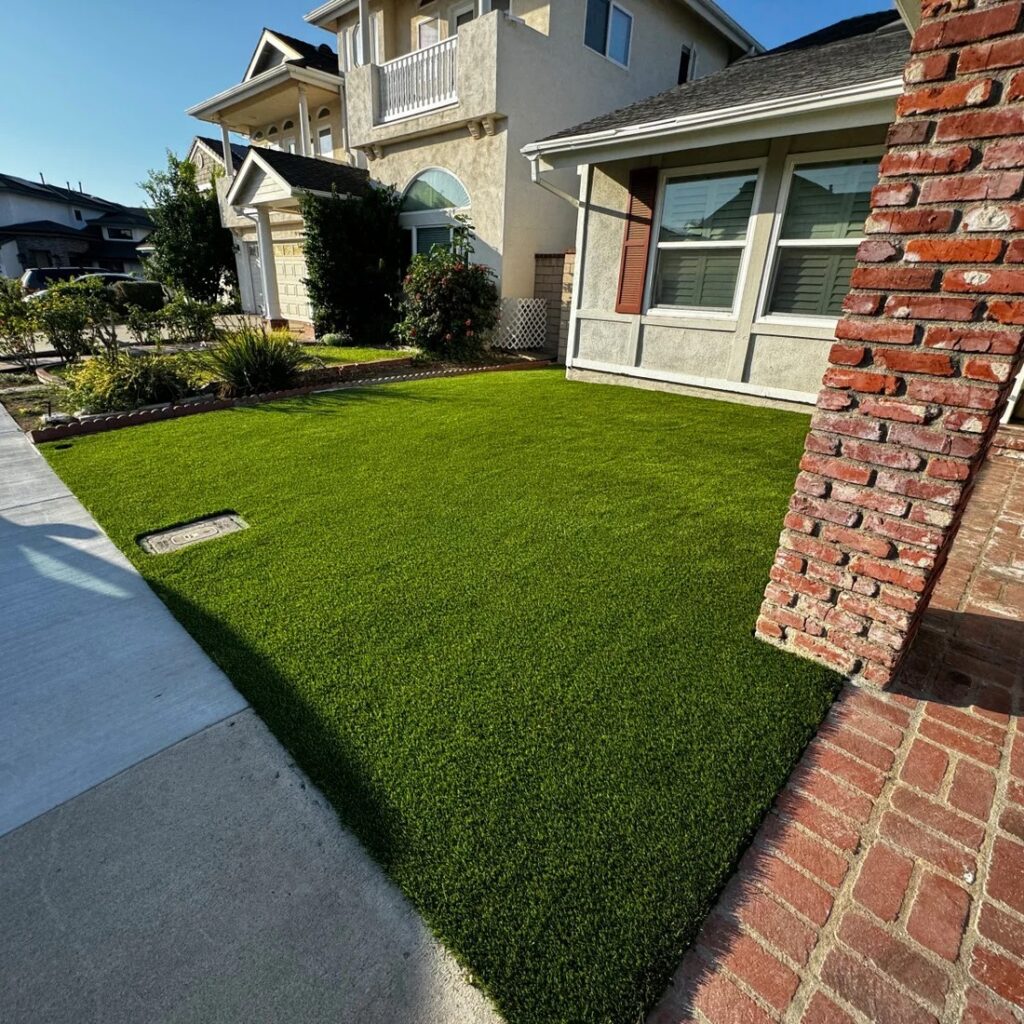
Enhancing Your Lawn Project: Complementary Landscaping
Borders and Edging
Create definition and style with:
- Stone borders: Natural stone edging complements turf beautifully
- Concrete curbing: Permanent, clean lines that enhance property value
- Planted borders: Drought-tolerant native plant borders reduce overall water usage
- Metal edging: Modern look that creates clear boundaries
Incorporating Hardscaping
Balance your new turf with hardscape elements:
- Stepping stones: Create pathways through larger turf areas
- Seating areas: Patios or decks that extend living space
- Retaining walls: Functional and attractive for sloped properties
- Water features: Small fountains or ponds add tranquility

Conclusion: Your DIY Lawn Turf Success
Following this comprehensive DIY lawn turf installation guide will help Orange County homeowners create beautiful, sustainable lawns that enhance property value and provide enjoyable outdoor spaces. By understanding the specific requirements of Southern California’s climate and implementing proper installation techniques, your turf installation project can result in a lush, vibrant lawn that thrives for years to come.
Remember that proper preparation is the key to success, and taking the time to complete each step thoroughly will reward you with better results. Whether you’re renovating your front yard to improve curb appeal or creating a backyard retreat for family enjoyment, this DIY lawn turf installation guide provides all the information you need for a successful project.

